40 years of Audi five-cylinder engines – Audi introduced a five-cylinder engine in its model range for the first time in 1976. Since then, the powerful yet efficient unit has been a cornerstone of the Vorsprung durch Technik brand. The latest iteration produces a heady 400PS in the TT RS Coupé and Roadster, catapulting both to 62mph in less than four seconds and on to a potential top speed of 174mph. It is the most powerful road-going iteration of the five-cylinder engine that Audi has ever produced.

1976: first five-cylinder petrol engine in the automotive industry
In August 1976, Audi introduces the second-generation Audi 100 (C2) in Luxembourg. For the first time, power is provided by a five-cylinder petrol engine in a model from the brand with the four rings. The fuel-injected engine with a displacement of 2,144 cc develops 136PS at 5,700 revolutions per minute. The maximum torque of 185 newton metres (136.45 lb-ft) is available at 4,200 rpm. The market launch of the Audi 100 (C2) follows in March 1977. From September 1979, the five-cylinder engine is also available in the Audi 200; from August 1982, it is fitted in the successor to the C2, the Audi 100 C3.This Picture: Audi 100 GLS 5E (C2), model year 1979

1978: five-cylinder carbureted engine
In April 1978, the five-cylinder carbureted version with an output of 115PS replaces the basic two-litre four-cylinder version in the Audi 100 (C2). The new 1.9-litre unit produces maximum power at 5,400 revs and delivers 154 newton metres (113.58 lb-ft) of torque to the crankshaft at 3,700 rpm. The engine is used in the Audi 100 5 (C2), the Audi 80 CD (B2), the Audi Coupé GT 5S (B2) and in the Audi 100 (C3). This picture: Audi 80 CD (B2), model year 1982
In 1978, Audi presents its first diesel model for the Audi 100 (C2). The five-cylinder naturally aspirated engine with a displacement of two litres develops 70PS and 123 newton metres (90.72 lb-ft) of torque. It also powers the next-generation C3, propelling both the sedans and the Avant versions. From 1984, there is a turbocharged engine with an output of 87PS and 172 newton metres (126.86 lb-ft) of torque. This picture: Audi 100 GL 5D (C2), model year 1978

1980: five-cylinder petrol engine with turbocharger
In 1980, the Audi 200 5T (C2) comes on to the market, which is powered by the first turbocharged petrol engine from the brand with the four rings. From a displacement of 2,144 cc, the five-cylinder unit produces 170PS at 5,300 revolutions per minute and 265 newton metres (195.45 lb-ft) of torque at 3,300 rpm. The Audi 200 5T (C2) is the first Audi in the luxury class and features the lavish equipment of the Audi 100 CD as standard. This picture: Audi 200 5T (C2), model year 1981

1980: five-cylinder petrol engine with turbocharger & intercooler
In 1980 at the Geneva Motor Show, Audi unveils the Audi quattro (B2), known as the “Ur-quattro” from the mid-1990s. It uses the powerplant from the Audi 200 5T (C2), but features an intercooler. As a result, the turbocharged engine achieves a higher output of 200PS at 5,500 revolutions per minute and 285 newton metres (210.21 lb-ft) of torque at 3,500 rpm. The body of the Audi quattro is based on the Audi Coupe (B2), which in turn is based on the Audi 80. Flared arches, bulkier bumpers and sills as well as a larger rear spoiler distinguish the Audi quattro from the Coupe. This picture: Audi quattro (B2), model year 1980 (Geneva Motor Show)

1983: five-cylinder engine triumphant in rallying
In the 1983 Corsica Rally, Audi competes for the first time with the Audi quattro A2, Group B. Its 2.1-litre turbocharged five-cylinder inline engine produces 360PS at 6,500 revolutions per minute and delivers 450 newton metres (331.90 lb-ft) of torque at 4,000 rpm. At the end of the season, the Finn Hannu Mikkola wins the drivers’ title in this car. One year later, the Swede Stig Blomqvist replicates this success: he becomes world rally champion, while Audi wins the manufacturers’ world rally championship for the second time after 1982. This picture: Audi quattro A2, Group B, model year 1983

1983: five-cylinder petrol engine with four-valve technology
In September 1983, Audi presents the Audi Sport quattro (B2) at the International Motor Show in Frankfurt am Main. It is powered by a 2.1-litre high performance engine with four-valve technology that produces 306PS at 6,700 revolutions per minute. The maximum torque of 350 newton metres (258.15 lb-ft) is available at 3,700 rpm. Delivery commences in May 1984. The Audi Sport quattro (B2) is a special series limited to 214 vehicles, produced to meet homologation requirements for rallying. The rules stipulate that displacement must be limited to a maximum of 2,133 cc. This picture: Audi Sport quattro (B2), model year 1984

1984: map-controlled five-cylinder petrol engine
1984: map-controlled five-cylinder petrol engine with emissions control as standard In 1984, a completely new development appears. Audi is the first manufacturer to optimise the five-cylinder engine with a fully electronic map-controlled ignition system and a catalytic converter as standard. From 2,309 cc, it produces 136PS at 5,600 rpm and 188 newton metres (138.66 lb-ft) of torque at 3,500 revolutions per minute. The most widely used five-cylinder engine from Audi is found in the Audi 100 2.3E (C3), the Audi Coupe 2.3E (B3) and in the Audi 90 2.3 E (B3). From 1990, it also powers the Audi 100 2.3E (C4) and a year later the Audi 80 2.3E (B4) and the Audi Cabriolet 2.3E. Here, it delivers 133PS at 5,600 revolutions per minute and 186 newton metres (137.19 lb-ft) at 4,000 rpm. This picture: Audi Coupé 2.3E (B3), model year 1989

1987: world record at Pikes Peak with the Audi Sport quattro S1
In 1987, Walter Röhrl wins the legendary Pikes Peak Hill Climb (USA) in the Audi Sport quattro S1 (E2), setting a new record. In 10 minutes and 47.85 seconds he conquers the almost 20-kilometre-long (12.43 mi) course with 156 bends and a difference in altitude of 1,439 metres (4721.13 ft). The 2.1-litre five-cylinder engine in the Audi Sport quattro S1 (E2) delivers 598PS at 8,000 revolutions per minute and produces 590 newton metres (435.16 lb-ft) of torque at 5,500 rpm. This picture: Audi Sport quattro S1 (E2), model year 1987

1988: five-cylinder petrol engine with four-valve technology
With two catalytic converters, four-valve technology, a closed tank venting system and a diagnostic system, this powerplant offers a very high standard of emissions control and technology. It is first available in the Audi 200 quattro 20V (C3), then in the Audi quattro 20V (B2) a year later and in the Audi S2 Coupe (B3) in 1990. The five-cylinder turbocharged engine has a displacement of 2,226 cc and delivers 220PS at 5,700 revolutions per minute and 309 newton metres (227.91 lb-ft) of torque at 1,950 rpm. This picture: Audi 200 quattro 20V (C3), model year 1990

1989: most powerful five-cylinder works engine in motorsport
At the 1989 IMSA GTO in the USA, the Audi 90 quattro competes in its races with the most powerful five-cylinder works engine. The turbocharged aluminium engine is a 2.2-litre high-performance unit specially designed for racing. It develops 720PS at 7,500 revolutions per minute and delivers 720 newton metres (531.04 lb-ft) of torque at 6,000 rpm. Overall, the Audi 90 quattro IMSA GTO wins seven races in the American touring car series in the 1989 season. This picture: Audi 90 quattro IMSA GTO, model year 1989

1989: first five-cylinder turbocharged direct-injection engine
Audi presents another milestone in the automotive history in 1989 at the International Motor Show in Frankfurt am Main: the Audi 100 TDI. The first five-cylinder turbocharged diesel with direct injection for a production car produces 120PS from a displacement of 2.5 litres and delivers 265 newton metres (195.45 lb-ft) of torque to the crankshaft. It is used in the C3 and in the C4 – from 1994 with an output of 140PS and 290 newton metres (213.89 lb-ft) of torque. This picture: Audi 100 TDI (C3), model year 1990

1991: performance-enhanced five-cylinder S engine
In the 1991 Audi S4, the Sport version of the Audi 100 (C4), a turbocharged 2.2-litre 20-valve five-cylinder inline engine is at work. It develops 230PS at 5,900 rpm. Thanks to a brief increase in boost pressure, a peak torque of 350 newton metres (258.15) is achieved at 1,950 revolutions per minute. The engine also powers the Audi S2 Avant (B4) and the Audi S2 Coupé (B3). In 1994, the Audi S4 becomes known as the Audi S6. This picture: Audi S2 Avant (B4), model year 1992

1994: first five-cylinder RS engine
In 1994, the most powerful five-cylinder production engine built by Audi to date goes into action in the Audi Avant RS 2 (B4). With turbocharging, fuel injection and standard-fit emissions control, it produces 315PS at 6,500 revolutions per minute from a displacement of 2,226 cc and delivers 410 newton metres (302.40 lb-ft) of torque at 3,000 rpm. This picture: Audi Avant RS 2 (B4), model year 1994

2009: 2.5 TFSI with petrol direct injection, turbocharger
30 years after the first five-cylinder turbocharged petrol engine was presented, Audi once again introduces a model with a five-cylinder petrol engine and turbocharger at the Geneva Motor Show: the TT RS. The powerplant delivers 340PS at 6,500 revolutions per minute from 2,480 cc and 450 newton metres (331.90 lb-ft) at 5,300 rpm. From 2011, this engine is also used in the RS 3 Sportback and from 2014 in the updated RS Q3. In the 2012 TT RS plus, the engine produces 360PS at 6,700 revolutions per minute and develops 465 newton metres (342.97 lb-ft) of torque at 5,400 rpm. This picture: Audi TT RS Roadster, model year 2009

This picture: Audi RS 3 Sportback, model year 2011

2010: Audi TT RS in races
In 2010, Audi starts its motorsport activities with the TT RS. The racing car developed for endurance racing is powered by the five-cylinder engine from the production model. Following improvements to the intercooler and exhaust system, the powerplant delivers 380PS at 5,800 revolutions per minute. The maximum torque of 500 newton metres (368.78 lb-ft) develops at 2,500 rpm. In the VLN Endurance Championship of 2010 and 2011, the front wheel-drive racing car notches up several victories in the SP4T class up to 2.5 litres’ capacity. In August 2011, it clinches overall victory in the 6-hour race on the Nürburgring. Audi achieves further success with the TT RS in the 24-hour race in the Eifel in 2011, where it takes class victory. This picture: Audi TT RS racing car, model year 2011

2015: 2.5 TFSI with petrol direct injection, turbocharger
In the summer of 2015, the second-generation RS 3 Sportback appears – the most powerful car in the premium compact segment with an output of 367PS. The combination of turbocharging and direct injection permits a high compression ratio of 10:1 and correspondingly good efficiency. The five-cylinder inline engine delivers a maximum of 465 newton metres (342.97 lb-ft) to the crankshaft. This torque is available from as low as 1,625 revolutions per minute and remains constant up to 5,550 rpm. Since spring 2016, Audi has been using the optimised version of the powerplant in the Audi RS Q3 performance too. This picture: Audi RS 3 Sportback, model year 2015

At the Beijing Motor Show in 2016, Audi presents the new TT RS Coupe and the new TT RS Roadster. The five-cylinder unit has been enhanced in every area – with lightweight construction measures, reduced internal friction, increased power delivery. From an unchanged displacement of 2,480 cc, the turbocharged engine gains a good 17 percent increase in performance. With an output of 400PS it is more potent than ever before. The maximum torque of 480 newton metres (354.03 lb-ft) is available between 1,700 and 5,850 revolutions per minute. It ensures outstanding pulling power, which accompanies the unmistakable five-cylinder sound. This picture: Audi TT RS Coupé, model year 2016
THE AUDI FIVE-CYLINDER AT 40 – A LEGACY LIVES ON
Evocative Audi powerplant celebrated for its mighty on-road performance and significant motorsport success reaches a historical milestone
- Five-cylinder engine delivering 136PS presented for the first time in 1976 in the Audi 100
- Highly successful engine concept for series production and rallying
- 2.5 TFSI voted “Engine of the Year” seven times in a row since 2010
- All-new TT RS continues to be powered by five-cylinder 2.5 TFSI, now producing 400PS and 480Nm
Ingolstadt, August 30, 2016 – 40 years ago, Audi presented the first five-cylinder petrol engine in the second-generation Audi 100. Enhancements and new developments followed, with turbocharging, emissions control and four-valve technology, rally engines and five-cylinder diesel units. Today, the 2.5 TFSI in the Audi TT RS Coupé and Roadster carries on the great tradition of five-cylinder powerplants.
The five-cylinder engines from Audi have achieved cult status – partly due to their successful deployment in motorsport and also on account of their reliability and economy. They have played a vital role in definingVorsprung durch Technik and to this day provide an emotional driving experience with their characteristic sound.
The first five-cylinder petrol engine powered the Audi 100 (C2) in 1976. The model, known internally as Type 43, was to be positioned higher than its predecessor in the market. The four-cylinder engines at the time were not suitable for this plan according to the developers. At the beginning of the 1970s, Audi engineers consequently discussed the possibility of introducing five and six-cylinder inline engines. The latter were ruled out due to the installation space required and unfavourable weight distribution. So those responsible opted for the five-cylinder inline engine, based on the new EA 827 engine concept.
This four-cylinder inline engine was used throughout the VW Group in the 1970s – in the Audi 80 and Audi 100, for instance. The derived 2.1-liter five-cylinder engine produced 136PS. A modern injection system increased efficiency and power development. Delivery of the Audi 100 5E began in March 1977.
As early as 1978, Audi presented the first diesel version: a naturally aspirated diesel with a displacement of two litres and producing 70PS. One year later, the first turbocharged five-cylinder petrol engine made its debut – another pioneering feat from Audi. With an output of 170PS and 265 newton metres (195.45 lb-ft) of torque, it powered the new top model, the Audi 200 5T. The five-cylinder petrol engine in the 1980 Audi “Ur-quattro” had even more to offer.
With turbocharging, an intercooler and permanent four-wheel drive, it constituted a powerful technical package for the racetrack and the road. Initially, it delivered 200PS. In 1983, the Finn Hannu Mikkola won the drivers’ title in the World Rally Championship in this car. In the same year, Audi introduced the wide-track Sport quattro, which was 24 centimetres (9.45 inches) shorter. It was powered by a newly developed four-valve five-cylinder unit made of aluminium with an output of 306PS. It made the Sport quattro the most powerful car built to date by a German company for use on public roads. The model formed the basis for a new Group B rally car, with the four-valve powerplant delivering 450PS from the very start. It was used for the first time in the penultimate race of 1984, the Ivory Coast rally. The other eleven rounds of the season were contested by the Swede Stig Blomqvist in the Group B Audi quattro A2 producing 360PS. In the end, he won the drivers’ title and Audi took the manufacturers’ title.
Even after Audi withdrew from rallying in 1986 there were other racing highlights: in 1987, Walter Röhrl won the Pikes Peak Hill Climb (USA) in the Audi Sport quattro S1 (E2). The racing car developed 598PS. And the IMSA GTO excelled on the US touring car scene in 1989, delivering 720PS – from little more than two litres of displacement.
Audi presented another milestone in automotive history at the International Motor Show in Frankfurt am Main in 1989: the Audi 100 TDI. It was the first production car with a five-cylinder direct-injection turbocharged diesel engine and fully electronic control. The powerplant generated 120PS from a displacement of 2.5 litres.
Audi continued to refine its range of five-cylinder petrol engines. In 1994, the Audi RS 2 with an output of 315PS came on to the market. As an Avant with the power of a sports car, it established a new automotive class.
1994 saw the five-cylinder units bow out of the B segment, when the Audi A4 (B5) was introduced. They were gradually replaced in the mid-1990s by the new V6 engines. The last five-cylinder engines, the 2.5 TDI in the Audi A6 and the 2.3 Turbo in the Audi S6, were phased out in 1997.
Then in 2009 there was a big comeback – with turbocharging and petrol direct injection in the Audi TT RS. The transverse-mounted engine developed by quattro GmbH produced 340PS from a displacement of 2.5 litres. It also offered outstanding performance in the RS 3 Sportback and in the RS Q3. The TT RS plus, which Audi presented in 2012, mustered up an impressive 360PS. Today, the 2.5 TFSI in the Audi TT RS produces 400PS. An international jury of motoring journalists has voted the five-cylinder powerplant “Engine of the Year” seven times in a row since 2010.
Those who would like to see the first Audi with a five-cylinder engine can currently do so at the Audi Forum in Neckarsulm. The classic car exhibition entitled “From zero to 100” features numerous exhibits, which Audi uses to look back at the eventful history of its successful model. One of the first five-cylinder TDI units from a 1989 Audi 100 is also on display. The exhibition runs until November 6, 2016.

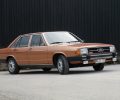
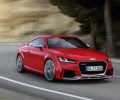
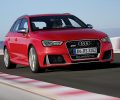
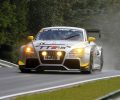
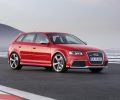
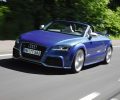
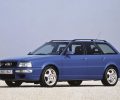
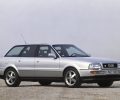
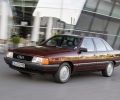

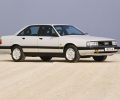
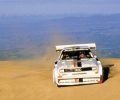
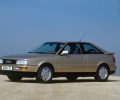
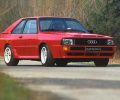
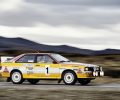
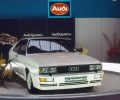
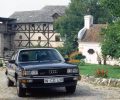
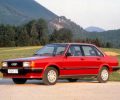
You must be logged in to post a comment.